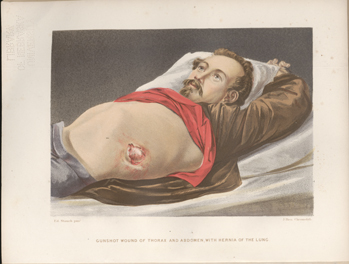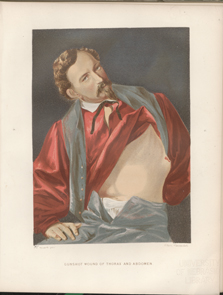Title: Stolpe, Robert
Source text: Surgeon General Joseph K. Barnes, United States Army, The Medical and Surgical History of the War of the Rebellion. (1861–65.), Part 1, Volume 2 (Washington, D.C.: Government Printing Office, 1870), 515.
Civil War Washington ID: med.d1e19661
TEI/XML: med.d1e19661.xml
CASE.—Captain Robert S——, Co. A, 29th New York Volunteers, was wounded at Chancellorsville, on May 2d, 1863. A round musket ball, fired from a distance of about one hundred and fifty yards, entered the eighth intercostal space of the left side, at a point nine and one-half inches to the left of the extremity of the ensiform cartilage, and fractured the ninth rib. Without wounding the lung apparently, the ball passed through the diaphragm, and entered some portion of the alimentary canal. Captain S. walked a mile and a half to the rear, and entered a field hospital. On examining his wound, the surgeons found a protrusion of the lung of the size of a small orange, which they unavailingly attempted to reduce. The wound was enlarged, and still it was impracticable to replace the protruded lung. On May 3d, the field hospital, where Captain S. lay, was exposed to the enemy's fire. He walked half a mile further to the rear, and was there placed in an ambulance, and taken across the Rappahannock, at United States Ford, to one of the base hospitals. Here fruitless efforts were again made to reduce the hernial tumor, after which a ligature was thrown around its base and tightened. A day or two subsequently, the patient passed into the hospital of the 2d division of the Eleventh Corps, into the hands of Surgeon Robert Thomain, 29th New York Volunteers, who removed the ligature from the base of the tumor. A small portion of gangrenous lung separated and left a clean granulating surface beneath. On May 7th, the ball was voided at stool. On May 8th, the patient was visited by Surgeon John H. Brinton, U. S. V., who found him walking about the ward, smoking a cigar. There was an entire absence of general constitutional symptoms; no cough, no dyspnœa, no abdominal pain; the bowels were regular and appetite good. The protruding portion of the lung was carnified; there was a dulness on percussion, and absence of the respiratory murmur in a zone an inch and a half in width around the circumference of the base of the tumor. Surgeon Thomaine Thomain stated that the hernia had been gradually diminishing in volume. It was, at this date, half the size of an egg, and covered with florid granulations. On May 10th, a drawing of the parts was executed by Mr. Stanch, artist of the Army Medical Museum. (See Chromolithograph No. XI.) On June 2d, Captain S. was transferred to Washington. There was an elastic, partly reducible tumor, over which was an oval granulating surface an inch and a half by three-fourths of an inch. The vesicular murmur was perfect throughout the lung, except in the immediate vicinity of the tumor. Compression of the tumor was advised. After a furlough of sixty days, Captain S. was again examined. The wound had entirely healed; the respiratory sounds were normal; there was still a slight hernia of the lung. The general health of the patient was excellent. At this date a second drawing was executed. (See Chromolithograph No. XII.) The captain was discharged from service on June 20th, 1863, and was subsequently pensioned. On May 19th, 1864, Pension Examiner E. Swift reports the patient to he entirely incapacitated from the wound, which, at that date, was considerably tumefied. He rates his disability total and temporary. September 19th, 1865: The tumor is reported to be undiminished in size and painless. The patient can take ordinary, leisurely exercise, but is unable to run up and down stairs. He has no cough, but suffers somewhat from gastric symptoms, his stomach being easily disturbed. The extra-thoracic tumor is resonant on percussion. The air, in entering, produces a crepitant crack ling sound; the expiratory murmur is feeble. March 14th, 1867: Two months ago, the tumor suddenly enlarged after straining efforts at lifting, being now five inches in its long and four and a half inches in its transverse diameter. The respiratory sounds are feeble. There is often nausea after eating, and great pain, referred to the tumor. Pressure over the tumor causes a gurgling sound, simulating the presence of air within the tumor, and borborygamus throughout the intestines. The patient declares his inability to eat meat. The contents of the tumor are not reducible; traction on it and its contents produce nausea. A portion of the stomach has undoubtedly escaped through the diaphragm, and through the opening in the thoracic walls. A bandage, so arranged as to retain the tumor within its present limits and prevent further enlargement, was applied. A letter from the patient, dated January 23d, 1870, leads us to infer that this bandage has fulfilled its indication. On January 31st, 1870, the patient was reported to have, in addition to his other troubles, a hernia of the stomach, which viscus passed up through the diaphragm and thence through the opening in the rib, so that the tumor on the left side contained both lung and stomach. He wore a compressing bandage. On July 20th, 1872, Dr. Wm. H. Romig, of Allentown, Pennsylvania, the family physician of Captain Stolpe, writes : "The hernial tumor is of a doughy consistence, its surface smooth, measures in its longest diameter four and a half inches. Stolpe says, it appears smaller at times; it cannot be reduced by taxis, neither can any communication be discovered with the internal organs. Never gives pain, but dyspnœa is produced upon hastening his pace or heavy lifting; cannot lie on his left side for same reason; cannot expand his lung fully, that is, beyond normal use. His stomach will take food often, but not much at a time; the left side of his body does not appear so strong as the right. Weighs about one hundred and sixty pounds, and enjoys good health."

